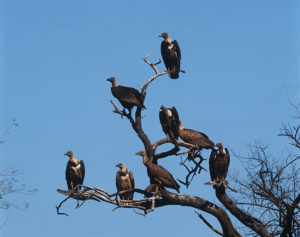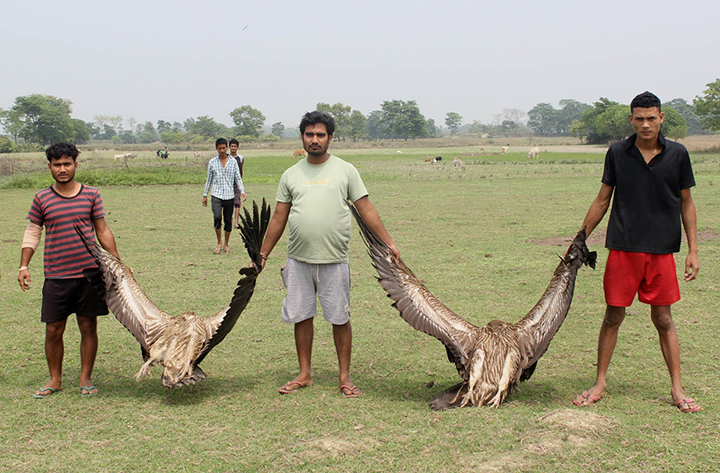The banning of diclofenac as a pesticide should have saved the vulture population from extinction but now it is under threat from anti-inflammatory drugs used on animals. A ban on these drugs is urgently needed, say conservationists
If there is one bird that as a child, growing up, you would not want to encounter would be the vulture. If you were growing up in the ’90s in Delhi, you could still spot them, swooning up above, their scrawny necks and pointy beaks reminding you of a wicked character from the movies.
Nowadays, though, you would feel lucky to catch sight of even one and it is pretty awe-inspiring, like seeing a mythical creature. The vulture has faced its fair share of disdain — not an iota of love for its features — unlike its carnivorous cousin, the eagle.
There has been, over the years, a focus on the depleting numbers of the vulture population, which is now a situation of near extinction. Conservation efforts are on but three species of vultures which are the worst affected and critically endangered – the white-rumped vultures, the Indian vultures and the slender-billed vultures – have had 99% of their population wiped out in India.
The biggest culprit in this shattering scenario are non-steroidal anti-inflammatory drugs (NSAIDs) used for veterinary purposes. Dr Vibhu Prakash Mathur, Principal Scientist at Bombay Natural History Society and Project Manager for the Vulture Conservation Breeding Centre, Pinjore, Haryana points to these very lethal painkiller medications.
The latest plea in the National Green Tribunal (NGT) that asked for the ban of NSAID use for veterinary purposes was filed by advocate Gaurav Bansal on behalf of Centre for Wildlife and Environment Litigation. He says the tribunal has asked them to approach the Ministry of Environment, Forest and Climate Change (MoEFCC).
This is not the first time that NSAIDs have been blamed for the depleting number of vultures. After years of research, Dr Mathur tells us, they found evidence of the lethal effects of diclofenac in veterinary use. In 2006, after a lot of concern was raised, the drug was banned and notified in 2008.
However, the use of this drug continues. One of the factors to blame is that the drug is still readily available for humans, and is misused. Other NSAIDs like aceclofenac, when administered in the animal body, metabolise into diclofenac, and ketoprofen are lethal to vultures when they eat a carcass riddled with these drugs.
On their part, researchers have approached the Drug Controller General of India, Dr Mathur says, who will then be taking the opinion of commissioners of animal husbandry. “We have requested them to ban these drugs.”
The latest plea in the NGT had requested the ban of exactly the same drugs. Bansal, who has been working on wildlife issues for the past four years, says that choosing Pinjore, Haryana for the establishment of the Vulture Conservation Centre was not the best idea. “They should have centres in Rajasthan’s Jaisalmer instead, which has had vultures. If a vulture is found dead there, to establish the cause of death, its remains would have to be transported to a facility in Chandigarh. This hampers research into just how harmful these drugs are proving to be”.
However, the main function of the Pinjore centre is to propagate the breeding of vultures. It is a joint project of the BNHS and the Haryana Forest Department to save the three species of vultures mentioned earlier from looming extinction. And this is just one just one of the conservation methods. They have started eight different conservation centres in the country, which includes one in Rajabhatkhawa, West Bengal, others in Rani, Assam and Bhopal, Madhya Pradesh.

But conservation efforts would not be successful if vultures are routinely killed by NSAIDs. In fact, Dr Mathur’s dismal projection is that 99.9% of the white-rumped vulture which was the most common of the three, has been wiped out. “We do carcass sampling throughout the country, and also do undercover pharmacy surveys. We have found the causes of death and that these lethal NSAIDs are rampantly sold without prescription.”
The depleting numbers of vultures has seen the rise in feral dogs, which poses the threat of a rise in rabies. Communities which traditionally collect bone and hide for trade have directly been affected by depleting vulture numbers Dr Mathur says. “They are the poorest of the poor. When vultures were in good numbers, they would be alerted when vultures circled the carcass. They would immediately get to the carcass and skin it before the dogs could get to it. After the skinning, the vultures would eat the meat, which would be cleaned to the bone and that would then be collected for gelatine. But now there aren’t enough vultures so when they do find a carcass, its skin has already been eaten by dogs. Traditional bone and hide collectors now are mostly out of business.”
The Wildlife Trust of India (WTI) points to another way in which the vulture is under threat. While these attacks are sporadic it is still cause for concern – that is secondary poisoning. Carcasses are riddled with poison and used as bait for feral animals but the unintended victim becomes the vulture. WTI says its vets have regularly been treating vultures for secondary poisoning in the North-east, particularly Sibsagar district of Assam.
Dr Rahul Kaul, Chief of Conservation at WTI says deaths caused by secondary poisoning are a cause for concern, but the one consolation is that such deaths are not rising. “They are sporadic and may happen once and then not happen for a few months before it happens again. I am not aware of how this is affecting the numbers in the wild because we are not involved in vulture enumeration but from experience, I can say that even small deaths can cause huge problems to an already depleted population of wild animals, in this case vultures.”
The major problem at hand are the NSAIDs which are still rapidly killing the vultures. Unlike in cases of poisoning when the vulture will be found at the site of poisoning itself, Dr Mathur points out that when vultures take a carcass with lethal NSAID, the death happens a few days later. “Thousands will die but no one sees it because when vultures feed on the carcass with NSAIDs like diclofenac, they feed on it and go back to their nesting place and die only after 5-6 days. That’s why they are a much bigger threat, it’s more rampant and it’s a silent killer. It took us almost 7-8 years to find out what was killing the vultures because it was never obvious”.
And now that they have, the hope for all of the wildlife researchers and others working on the field is that the government makes a concerted effort to keep the vultures alive, bans the lethal NSAIDs, and completely halts its non-prescription sale.
(Cover: FOOD DANGER: A picture from 2016 in Assam, when at least 20 endangered vultures were found dead after consuming a dead cow // PHOTO: Getty images)





